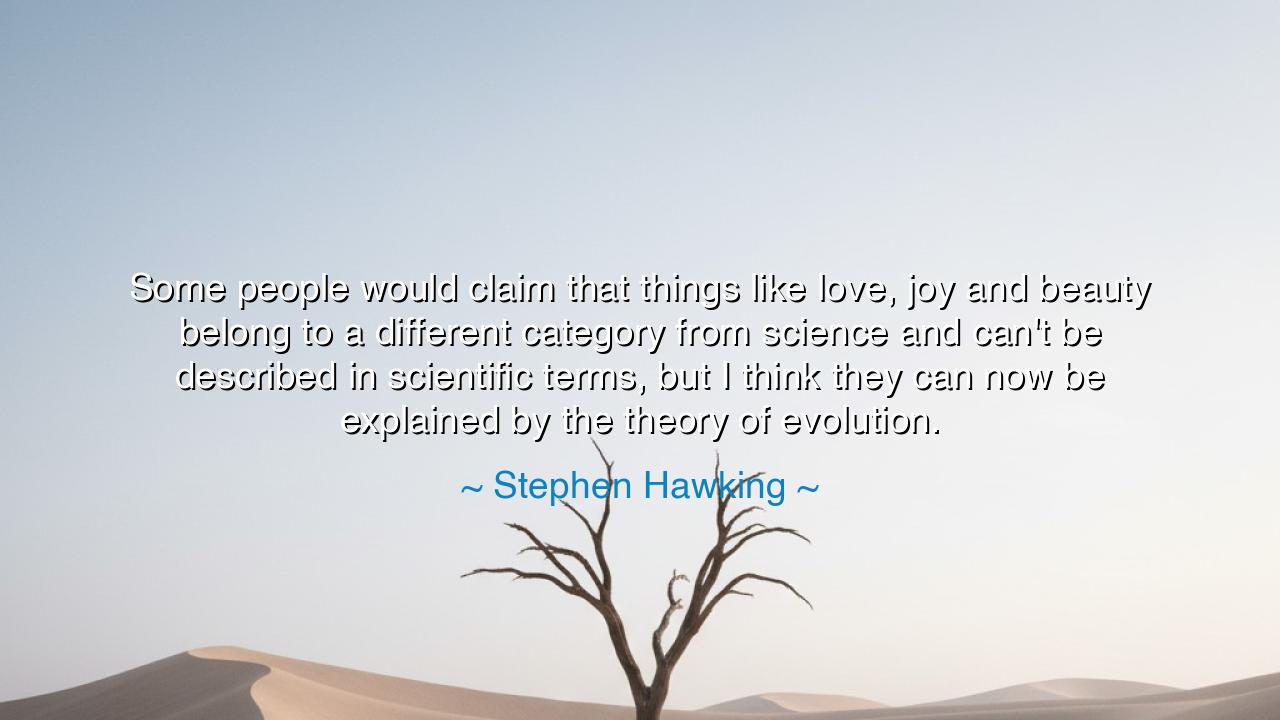
Some people would claim that things like love, joy and beauty
Some people would claim that things like love, joy and beauty belong to a different category from science and can't be described in scientific terms, but I think they can now be explained by the theory of evolution.






Hear now, O children of wisdom, the words of Stephen Hawking, whose brilliance has illuminated the darkest corners of the universe. He said, "Some people would claim that things like love, joy and beauty belong to a different category from science and can't be described in scientific terms, but I think they can now be explained by the theory of evolution." With these words, Hawking challenges the boundaries we often place between science and the most profound and mysterious aspects of human existence—love, joy, and beauty. These intangible elements, once thought to belong to the realm of art or emotion, are now seen by Hawking as products of the very same natural laws that govern the material world.
In the ancient world, the philosophers believed that the world was divided into the physical and the metaphysical, the visible and the invisible. Plato envisioned a world of forms, where beauty, justice, and truth were ideals, far removed from the tangible world of objects. To him, the physical world was a mere shadow of the true, ideal forms. Yet, Hawking’s words reflect a shift in thought—a movement toward understanding that even the most abstract emotions, those that seem to transcend the material world, may have natural origins, rooted in the evolutionary processes that have shaped life on Earth. Science, he suggests, is not confined to the material, but is capable of explaining even the most profound human experiences.
Consider the work of Charles Darwin, whose theory of evolution transformed our understanding of life itself. Darwin demonstrated that the diversity of life on Earth is not the result of some divine or metaphysical force, but the result of natural selection—a process that shapes species over time. Through evolution, we come to understand that our emotions, our desires, and our capacity for love and beauty are not separate from the physical world, but are deeply connected to our biological nature. Darwin showed that our feelings of attraction, affection, and even artistic appreciation are not arbitrary, but are part of the larger tapestry of life’s evolution, shaped by the forces that govern survival and reproduction.
In this way, Hawking builds upon Darwin’s insight, suggesting that emotions like love and joy are not just the stuff of poetry and philosophy, but are products of the evolutionary process. Love, for example, could be seen as a mechanism to bind individuals together, ensuring cooperation and bonding for the survival of the species. Joy and beauty, too, could have evolved as pleasures that encourage behaviors beneficial to the species, such as seeking the warmth of a family or appreciating the beauty of the natural world, which fosters a deeper connection to life. These deeply human experiences, often thought of as separate from the natural world, are now seen as intricately woven into the very fabric of our biological existence.
And yet, O children, the great lesson in Hawking’s words is that science and the human experience are not enemies but allies. For centuries, we have separated the rational from the emotional, the material from the spiritual, as if they were opposing forces. Yet, Hawking invites us to see that they are deeply connected. Science does not diminish the beauty of love or joy, but helps us understand their origins, their purpose, and their place in the grand tapestry of life. Just as Newton revealed the laws of gravity and Einstein unveiled the mysteries of space-time, Hawking asks us to look deeper into our own nature, to find the scientific roots of those very emotions that shape our lives and define what it means to be human.
Let the example of Albert Einstein guide you, who, though a man of reason, also understood that the universe, with its awe-inspiring beauty and complexity, could evoke the deepest emotions. He once said, "The most beautiful experience we can have is the mysterious." Einstein saw that science and emotion could coexist, that the search for knowledge and the pursuit of beauty were not separate but part of a unified quest to understand both the universe and our place within it. In this same spirit, Hawking calls us to embrace the science behind our emotions, to see that even our most profound experiences are part of the natural world and that love and beauty are not beyond the reach of science, but deeply intertwined with it.
So, O children of the future, take this wisdom to heart: the boundaries between science and emotion are not as fixed as we once believed. The science of evolution allows us to understand the deepest mysteries of the human heart, showing us that our most cherished feelings are not mere abstractions, but part of the natural, biological world that connects all life. Seek not to separate the rational from the emotional, but to understand how they work together, shaping the world around you. In this way, you will come to see the world not just through the lens of reason, but through the eyes of wonder, knowing that both science and emotion are essential to the fullness of human experience. Let them guide you on your journey, as you seek to understand both the cosmos and the depth of the human soul.






AAdministratorAdministrator
Welcome, honored guests. Please leave a comment, we will respond soon